ASSS6
| Location: Merricks | Australian Soil Classification: Bleached, Eutrophic, Brown CHROMOSOL |
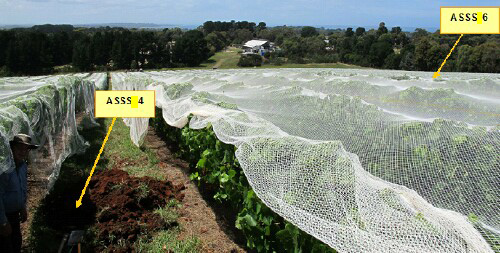
ASSSI 4-6Landscape
Soil Profile Morphology:
Surface Soil
| A1 | 0-15 cm | Dark greyish brown (10YR4/2); loam fine sandy; strong medium sub-angular blocky parting to fine sub-angular blocky structure; very firm consistence dry; pH 5.8; clear change to: | 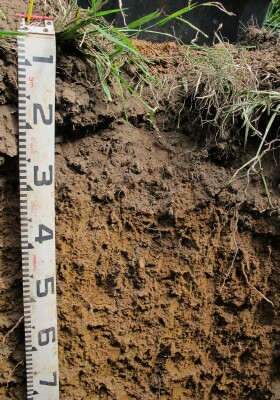 ASSSI 6Profile |
| A2 | 15-25 cm | Brown (7.5YR4/3) with a light brown sporadic bleach (7.5YR6/3d); fine sandy loam; strong medium sub-angular blocky structure; very firm consistence dry; pH 5.8; clear change to: | |
| Subsoil | |||
| B21 | 25-70 cm | Strong brown (7.5YR5/6) with few coarse distinct red (2.5YR5/8) mottles; medium clay; strong medium sub-angular blocky parting to very fine polyhedral structure; firm consistence moist; pH 5.9; gradual change to: | |
| B22 | 70-100 cm | Yellowish brown (10YR5/4) with few very coarse distinct red (2.5YR5/8) mottles; medium heavy clay; strong medium sub-angular blocky parting to very fine polyhedral structure; firm consistence moist; pH 5.8. | |
Key Profile Features:
- Strong texture contrast between surface (A) horizons and subsoil (B21) horizon.
pH | Salinity Rating | |||
Surface (A1 horizon) | Moderately Acid | Low | Non-Sodic | - |
Subsoil (B21 horizon) | Moderately Acid | Very Low | Non-Sodic | - |
Deeper subsoil (at 90 cm) | Moderately Acid | Very Low | Non-Sodic | - |
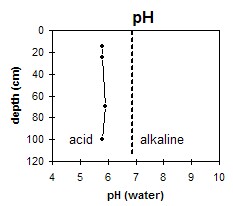 The soil profile is moderately acid throughout. | 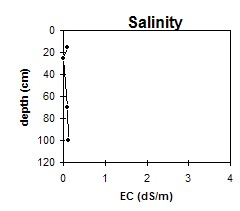 The salinity rating is low throughout the soil profile | 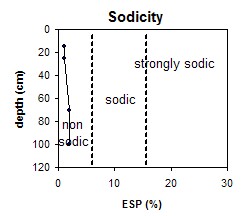 The soil profile is non-sodic throughout | 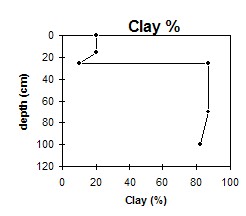 The clay content increases significantly at the A/B horizon interface |
Horizon | Horizon Depth | pH (water) | pH CaCl2 | EC 1:5 | Organic Carbon g/2100g | Exchangeable Cations | |||
Ca | Mg | K | Na | ||||||
Meq/100g | |||||||||
A1 | 0-15 | 5.8 | 5.2 | 0.1 | 3.8 | 6.2 | 2 | 0.13 | 0.2 |
A2 | 15-25 | 5.8 | 5.1 | <0.05 | 1.4 | 1.8 | 0.91 | <0.05 | 0.12 |
B21 | 25-70 | 5.9 | 5.5 | 0.1 | 4.5 | 6.1 | 0.22 | 0.49 | |
B22 | 70-100 | 5.8 | 5.6 | 0.12 | 3.2 | 8.1 | 0.15 | 0.71 | |
Horizon | Horizon Depth | Ext. Iron g/100g | Ex Al mg/kg | Ex Ac meq/100g | Wilting Point pF4.2 g/100g | Coarse Sand (0.2-2.0mm) % | Fine Sand (0.02-0.2mm) % | Silt (0.002-0.02mm) % | Clay (<0.002mm) % |
A1 | 0-15 | 0.62 | 10 | 12 | 42 | 23 | 20 | ||
A2 | 15-25 | 2.5 | 6.6 | 5 | 57 | 27 | 10 | ||
B21 | 25-70 | 7.6 | 1.41 | 13 | 2 | 4 | 7 | 87 | |
B22 | 70-100 | 13 | 3 | 9 | 6 | 82 |
Management Considerations
- Management strategies for all soils should include: increasing organic matter levels in the surface soil, minimising the degradation of soil aggregates and porosity, promoting the development of stable biopores, improving the calcium status of the cation exchange complex (particularly when sodium is a significant part), and breaking up any hardpans. Less frequent tillage, using less aggressive implements and working the soil at its optimum moisture content, can all assist in maintaining soil aggregation and porosity, as well as reducing the breakdown of organic matter. This is important for surface soil horizons such as here – that are high in fine sand and silt.
- The presence of sporadic bleaching in the subsurface (A2) horizon indicates that periodic waterlogging may occur above the more slowly permeable clay subsoil.
- Although with a very high clay content, the upper subsoil is non-sodic and well structured (parting to very fine sub-angular blocky peds) – indicating that root and water movement will be less restricted than for more sodic and coarsely structured subsoil horizons elsewhere.


